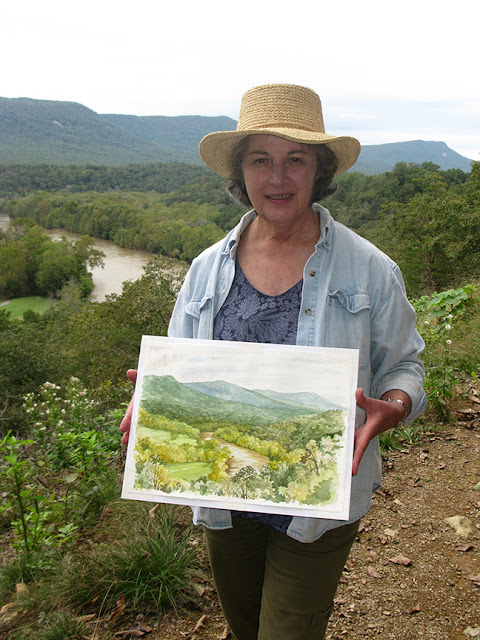 |
| The Shenandoah River from Culler Overlook, watercolor, 10" x 14" |
This past Saturday was the Plein Air Paint Day organized by Art in the Valley Gallery in Front Royal. The event coincided with the Annual National Public Lands Day, so everyone could enter the Shenandoah River State Park without paying the usual entry fee. This was a perfect opportunity for me, since I'd yet to visit this state park some five miles south of our town.
It was drizzling lightly when I woke up, and I was worried that our plein air day would get rained out, but the forecast didn't call for rain, just cloudy and overcast. So I packed up my gear in the car, made a sandwich for lunch and headed down to the gallery for our check-in. The gallery owners and staff are so nice! They had coffee, tea and scones to munch on at the gallery, and they had prepared goodie bags for all of us artists with water and snacks to take with us.
I arrived at the State Park and proceeded to Culler Overlook, which I'd been told gave the best panoramic views of the river. The view didn't disappoint--the wide bend of the river here reminded me a bit of the famous view of the Chama River in New Mexico, except that our hills here are covered with greenery, and show little of the underlying rock.
Two painters were already standing at the overlook--one gentleman had his painting well under way, and I recognized the other gentleman as Armand Cabrera, whom I'd met in the gallery at one of the opening receptions. Armand had not started on his canvas yet. I figured it might be a little too crowded with three of us there, so I walked down the trail leading below and found a nice spot under the shelter of some trees, just below the boardwalk--perfect!
I went back to my car and brought my gear and chair down. My working surface was relatively small--one quarter of a watercolor sheet, so I decided to paint only one side of the bend of river, to simplify the composition, and that worked.
After about an hour or so, another painter came down to the same spot to join me. I'd met Laura at the gallery before, but had forgotten her name. She told me she'd started blocking in the composition for her oil painting the day before, and set up behind me. Unfortunately, she seemed to be using turpentine (yuck!) rather than the less vapor-laden turpenoid and the fumes wafting down weren't pleasant. I tried my best to ignore it--thank heaven we were outdoors, and I could get up and walk around a bit to get away from it when it became too much.
After a while a young man showed up, who introduced himself as Casey and told us he was working with the gallery to take photos of the artists during the event. We obliged him by carrying on while he took his photos. Around twelve-thirty I took my lunch break, drove down to the visitor's center to use the bathroom and came back to eat my sandwich.
As the afternoon wore on, Laura and I chatted and I felt comfortable enough to tell her that she should ditch the turpentine because of its health hazards, and use turpenoid instead, with gloves on her hands to keep from absorbing toxins through her skin (she was picking up a lot of paint and turpentine on her hands). All these useful things I learned from my previous association with the Mid-Atlantic Plein Air Painters Association (MAPAPA), bless them!
The one good thing about having a cloudy day was that the light stayed consistent throughout the day, allowing for plenty of time to work on our paintings. It rained all of the next day-- almost an inch of rain-- so we were very lucky to have had the plein air painting on Saturday after all.
The paintings will be on exhibit at the gallery starting Oct. 12--can't wait to see what everyone else came up with!












